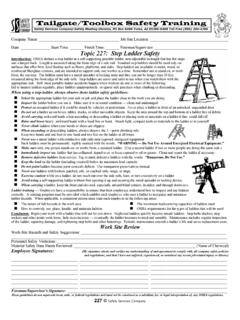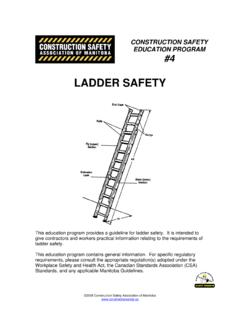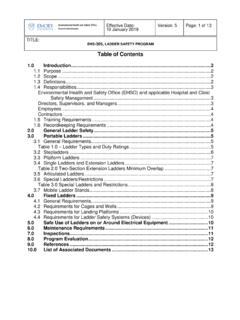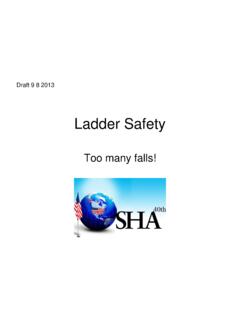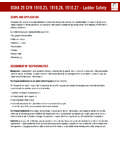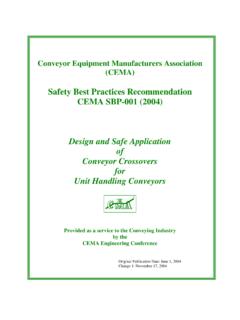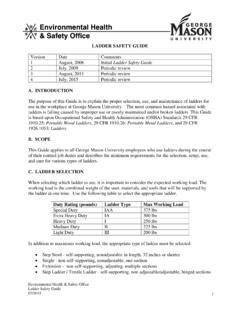Transcription of Ladder Safety Program - berryessa.k12.ca.us
1 1 Ladder Safety Program Berryessa Union School District 1376 Piedmont Road, San Jose CA 95132 408-923-1800 Updated February 2017 2 Ladder Safety Program Purpose and Scope The Berryessa Union School District (BUSD) has developed this Ladder Safety Program with the intent to put forth the regulations regarding Ladder Safety procedures and training at BUSD. This Program is in compliance with the Code of Federal Regulations (CFR) 1926, and Subpart X contains specific information on these rules. All BUSD employees who might be expected to use a Ladder during the course of work should be familiar with this document. This standard operating procedure covers various types of ladders including; step ladders, extension ladders and fixed ladders. Ladder users must be able to recognize and avoid Ladder hazards and be aware of safe practices in setting up, storing, moving and working from this equipment.
2 Responsibility 1. It is the responsibility of all Supervisors, Department Managers, Faculty and Staff to assure that all staff at BUSD who may use a Ladder read and understand this document. 2. It is the responsibility of Environmental Health and Safety to provide basic Ladder training Safety information to all departments in need of that training. 3. It is the responsibility of all Supervisors, Department Managers, Faculty and Staff to assure that all ladders being used at BUSD are free from defects and that all moving parts are working properly. 4. It is the responsibility of all Supervisors, Department Managers, Faculty and Staff to maintain records on departmental Ladder training. 5. It is the responsibility of Environmental Health and Safety to maintain records of Environmental Health Ladder Safety training sessions when they occur. Ladder Category Types 1.
3 Fixed Ladder - A Ladder that can not be easily moved or carried, and may be an integral part of a structure. 2. Type 1AA- Special Duty, Rugged Use, 375lbs Load 3. Type 1A- Extra Heavy Duty, Industrial Use, 300lbs Load 4. Type 1- Heavy Duty, Industrial Use, 250lbs Load 5. Type II- Medium Duty, Commercial Use, 225lbs Load 6. Type III- light Duty, Household Use, 200lbs Load Policy 1. All BUSD employees who use ladders should have Ladder Safety Training. 2. Ladder Safety Training will consist of recognition of possible hazards associated with Ladder use, proper maintenance and Safety precautions to be taken when using ladders. 3. All employees who use ladders at BUSD must inspect them for defects or possible hazards before the ladders are used. Ladders with loose parts or faulty rungs should be taken out of service immediately. 3 4. Ladders that are taken out of service should be tagged Defective and removed from the work area.
4 5. Whenever possible have someone within shouting distance while on a Ladder . Fixed Ladder Safety 1. Fixed ladders must be secured to the object they are attached to. 2. Fixed ladders over 20 feet must have a Safety cage surrounding the Ladder . 3. The Safety cage should have 15 clearance to all point from the center. 4. Defects in fixed ladders should be repaired as soon as possible. 5. When a defect is not repairable the Ladder must be take out of service. Safe Ladder Setup 1. All ladders must be placed on firm ground. 2. Do not set ladders on boxes, blocks or other objects that might move. 3. Do not lean or reach out while standing on ladders. 4. Secure ladders whenever a danger of slippage might occur. 5. Do not use ladders in high wind or during inclement weather conditions. 6. Never set up ladders in front of or around doors, unless the door is posted or locked.
5 7. Do not sit on ladders. 8. Use Safety shoes or other rubber soles shoes when climbing a Ladder Climbing and Standing on Ladders Safely 1. Always face a Ladder when climbing up or down. 2. Avoid carrying materials or tools when climbing a Ladder . Climb a Ladder first then pull up the materials with a rope. 3. Rung and steps should be clear of grease, oil, wet paint, snow and ice before climbing. 4. Do not climb onto a Ladder from the side. 5. Do not slide down a Ladder . 6. Climb or stand on a Ladder with your feet in the center of the rung. 7. Do not stand on the top rung or step of a Ladder Proper Use and Care of Ladders 1. Never use metal ladders near expose electrical wires. 2. Place warning signs or setup barriers around a Ladder before use. 3. Do not move a Ladder while someone is on it. 4. Never use a Ladder when under the influence of alcohol or prescription medications.
6 5. Do not leave tools or materials on top of ladders. 6. Only one person should be on a Ladder at a time. 7. Do not use a Ladder on a scaffold. 8. Do not try to rock a Ladder to move it. 9. Store wood ladders where they will not be expose to the elements. 4 10. Make sure ladders are properly secured when transported. Step Ladder Safety 1. Never use a stepladder over 20 feet in length. 2. Always open a stepladder completely and make sure the spreader is locked before use. 3. Do not stand higher then the second step from the top of a stepladder. 4. Do not straddle a stepladder. Extension Ladder Safety 1. The sections of an extension Ladder should overlap enough to retain the strength of the Ladder . a. Length of Ladder and required Overlap i. Up to 36 requires a 3 Feet Overlap ii. Over 36 to 48 requires a 4 Feet Overlap iii. Over 48 to 60 requires a 5 Feet Overlap 2.
7 Never Splice or tie two short ladders together 3. When using a Ladder for access to a landing, it must extend 3 rungs or 3 feet above a landing. 4. The top of an extension Ladder should rest against a flat, firm surface. 5. Elevate and extend these extension ladders at both the base and the top. Extension Ladder Setup 1. Lay a Ladder on the ground when it is collapsed. 2. Have someone foot the Ladder or make sure it is braced against something. 3. Pick up the Ladder and walk it to an upright position, making sure trees or wires will not obstruct it. 4. Slide the bottom of the Ladder outwards to the proper angel and set the feet correctly. 5. Then extend the Ladder by pulling the extensions line. 6. Make sure the rungs on the upper half of the Ladder are properly secured by the locking mechanism. 7. If possible, tie the Ladder off or have someone steady the Ladder as you climb it.
8 Additional References 1. Attachment A- OSHA Fact Sheet- Reducing Falls in Construction: Safe use of Extension Ladders 2. Attachment B- OSHA Fact Sheet- Reducing Falls in Construction: Safe use of Stepladders Updated on 2/2017 and approved through BUSD Safety Committee on 3/2017 FactSheetReducing Falls in Construction: Safe Use of StepladdersWorkers who use ladders in construction risk permanent injury or death from falls and electrocutions. These hazards can be eliminated or substantially reduced by following good Safety practices. This fact sheet examines some of the hazards workers may encounter while working on stepladders and explains what employers and workers can do to reduce injuries. OSHA s requirements for stepladders are in Subpart X Stairways and Ladders of OSHA s Construction is a Stepladder?A stepladder is a portable, self-supporting, A-frame Ladder .
9 It has two front side rails and two rear side rails. Generally, there are steps mounted between the front side rails and bracing between the rear side rails. (See Figure 1, below.)Figure 1: Stepladder PLAN Ahead to Get the Job Done competent person must visually inspect stepladders for visible defects on a periodic basis and after any occurrence that could affect their safe use. Defects include, but are not limited to: Structural damage, split/bent side rails, broken or missing rungs/steps/cleats and missing or damaged Safety devices. Grease, dirt or other contaminants that could cause slips or falls. Paint or stickers (except warning or Safety labels) that could hide possible the Right Stepladder for the Job with the Proper Load Capacity. Use a Ladder that can sustain at least four times the maximum intended load, except that each extra-heavy duty type 1A metal or plastic Ladder shall sustain at least times the maximum intended load.
10 Also acceptable are ladders that meet the requirements set forth in Appendix A of Subpart X. Follow the manufacturer s instructions and labels on the Ladder . To determine the correct Ladder , consider your weight plus the weight of your load. Do not exceed the load rating and always include the weight of all tools, materials and peDuty RatingUseLoad1A ASpecial DutyRugged375 Heavy DutyIndustrial300 DutyIndustrial250 DutyCommercial225 DutyHousehold200 for Types IA, I, II, III: Subpart X Stairways and Ladders, Appendix A (American National Standards Institute (ANSI) , , (1982)) of OSHA s Construction standards. Source for Type IAA: ANSI , , (2009), which are non-mandatory Workers to Use Stepladders must train each worker to recognize and minimize Ladder -related Stepladder Hazards Damaged stepladder Ladders on slippery or unstable surface Unlocked Ladder spreaders Standing on the top step or top cap Loading Ladder beyond rated load Ladders in high-traffic location Reaching outside Ladder side rails Ladders in close proximity to electrical wiring/equipmentSafe Stepladder Use DO:Read and follow all the manufacturer s instructions and labels on the Ladder .

